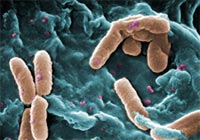This page is historical material reflecting the Feedback Loop Blog as it existed on
July 3, 2014. This page is no longer updated and links to external websites
and some internal pages may not work.
July 3, 2014
Although invisible to our immune system’s antibodies, strains of a pneumonia-causing bacteria, Pseudomonas aeruginosa (orange), are easily detected by galectins. Credit: Centers for Disease Control and Prevention.
When harmful strains of bacteria invade our bodies, our immune system produces antibodies that identify the intruders by the specific carbohydrate structures coating them. Some strains, however, have coatings that mimic the carbohydrate structures found on our own cells, and this disguise allows them to evade detection by antibodies.
A team of scientists led by Richard Cummings of Emory University found that galectins, a class of proteins naturally produced by our bodies, can identify and kill these concealed bacteria without damaging our own mimicked cells. To make this discovery, the team used glass slides covered with more than 300 different carbohydrates extracted from the surface of bacterial cells. After testing the ability of galectins and antibodies to bind to specific carbohydrates on these slides, the researchers observed that the galectins easily detected the mammalian-like carbohydrates that the antibodies failed to recognize.
These findings provide a clearer understanding of the complementary roles played by galectins and antibodies in protecting us from a broad range of infections.
This work also was funded by NIH’s National Institute of Allergy and Infectious Diseases and National Heart, Lung, and Blood Institute.
Learn more:
Emory University News Release 


